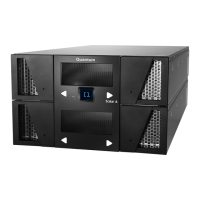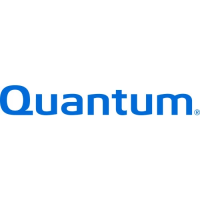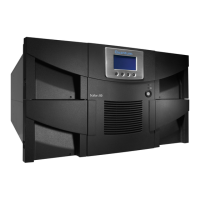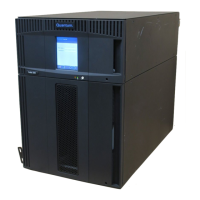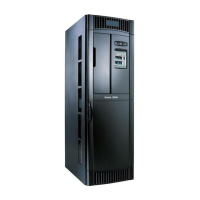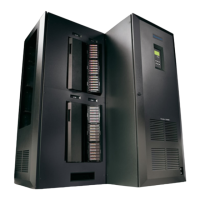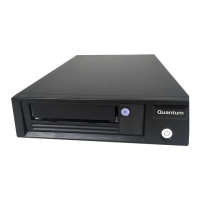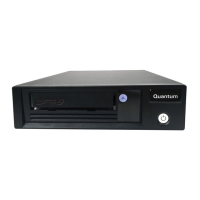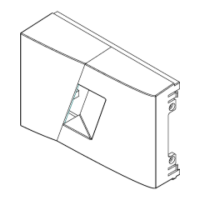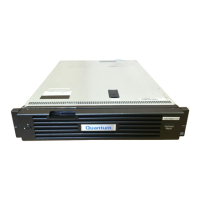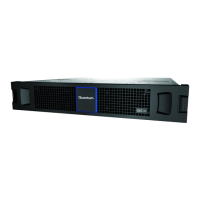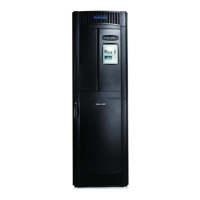





Do you have a question about the Quantum Scalar i6000 and is the answer not in the manual?
| Form Factor | Rack-mountable |
|---|---|
| Interface | Fibre Channel, SAS |
| Product Type | Tape Library |
| Cooling | Redundant cooling fans |
| Dimensions | Varies by configuration |
| Weight | Varies by configuration |
| Operating Humidity | 20% to 80% non-condensing |
| Scalability | Scalable |
| Drive Types | LTO |
| Redundancy | Redundant power supplies |
| Management | Web-based management |
| Tape Technology | LTO |
| Supported Media | LTO Ultrium 9, LTO Ultrium 8, LTO Ultrium 7, LTO Ultrium 6 |
| Power Supply | Redundant power supplies |
| Non-operating Humidity | 5% to 95% non-condensing |
Details safety precautions for operating the product, including warnings and cautions.
Explains the function of mechanical locks for access and service doors, emphasizing security.
Describes the power button on the operator panel and its function for electronics and picker power.
Informs about mercury content in lamps for energy-efficient lighting in certain components.
Provides information on the proper disposal and recycling of electrical and electronic equipment.
States the Scalar i6000 Regulatory Model Number as SCi6000.
Explains symbols and notes used throughout the document to highlight important information.
Lists other available documents for the product, found at www.quantum.com/support.
Details Quantum company contacts for ordering documentation and technical support.
Details how to get more information or help, including StorageCare services and support website.
Shows a front view of the library, consisting of a control module and an expansion module.
Details the library's design for ease of installation, configuration, and upgrades, including expansion modules.
Explains dual robotics requirements, parking modules, and their function and placement within the library.
Describes the control module, its functions via the library management module, and operator panel.
Explains how expansion modules increase library capacity for drives, I/E stations, and storage.
Details the library management module's function, location, and the boards it contains.
Describes the optional I/O management unit, its role in connectivity, and supported blades.
Details the supported Fibre Channel (FC) I/O blade type and its connectivity features.
Explains the Ethernet Expansion Blade (EEB) for Ethernet connectivity to LTO-5 or later drives.
Describes the robot's function in moving cartridges and its configuration for one or two robots.
Explains I/E stations for importing/exporting cartridges without interrupting operations.
Details I/E station options, including 24-slot and 72-slot configurations.
Explains how extended I/E configurations increase I/E slot count for partitions.
Describes how cartridges are stored in magazines within the library.
Describes cartridge magazines as storage assemblies containing cartridge slots.
Details supported tape drive types, hot-swapping, and firmware version compatibility.
Discusses six generations of LTO drives supported and their compatibility.
Explains rules for supporting LTO cartridges and drives in the same configuration.
Details WORM technology support in LTO drives and requirements for WORM functionality.
Describes the operator panel, its indicators, and the touch screen for library navigation.
Explains the library's power system, including single and redundant configurations and components.
Describes several library features such as density, centralized management, and proactive availability.
Explains the automatic verification and monitoring of data path integrity between hosts and drives.
Describes requests issued from the host application for cartridge movement and status information.
Explains how to manage the library locally or remotely using the Library Management Console (LMC).
Describes how Capacity on Demand allows licensing and purchasing of library slots as needed.
Describes how the library informs users of issues via subsystems, tickets, and notifications.
Explains tickets as the primary troubleshooting tool, covering details, reports, and resolution.
Provides guidelines for quickly troubleshooting issues using tickets and understanding issue causes.
Describes how to display detailed ticket information, associated reports, and repair pages.
Explains how the library creates key reports for issues and subordinate reports for updates.
Describes how to view tape alerts and generate media integrity analysis reports for drives and cartridges.
Explains how to view command and response activity for library devices to isolate issue sources.
Provides instructions on accessing the library’s Online Help system for further assistance.
Explains how to use the Setup Wizard command to initially configure library settings.
Details the process and situations requiring the enabling of license keys for library features.
Describes partitions as abstractions of the library for file management and host application access.
Explains media type checking, policy, and return media identifier settings for partition configuration.
Details the three ways to create library partitions: automatically, manually (simple mode), and manually (expert mode).
Explains the process to change drive and storage magazine allocation in existing partitions.
Provides instructions on how to delete a partition, emphasizing the need to recreate it for host access.
Details how to define a control path for each partition to connect it to a host application.
Explains how to configure two network settings (Interface 1 and Interface 2) for the library.
Describes connectivity commands including Port Configuration, Datapath Conditioning, and FC Host Port Failover.
Explains how to configure various operating modes for the physical library.
Provides instructions on how to set or reset the system time and synchronize the library over a network.
Details how the library uses email settings for sending snapshots, logs, and notifications.
Explains how to set up library notifications to send email messages for specific severity levels of issues.
Explains the Active Vault feature, its requirements, and how it manages partitions and unlicensed slots.
Describes how to configure Active Vault policies on standard partitions, involving export redirection.
Provides steps to create one or more library managed Active Vault partitions using Expert Mode.
Explains how to configure library access for external applications to direct media to Active Vault partitions.
Details how to create, modify, or remove policies on standard partitions for Active Vault configuration.
Describes how to review configured policies for Active Vault partitions via the Wizard or Monitor menu.
Collects information on all media, including lifetime usage metrics and associated errors.
Details how to view tape alerts and generate media integrity analysis reports for drives and cartridges.
Explains how to configure automatic RAS ticket notifications when media is moved in or out of the library.
Provides information on media usage, including history, errors, and status.
Allows scheduling of reports to be automatically generated and emailed to designated recipients.
Details the requirements for using AMP, including licenses, partitions, and storage slots.
Explains how to set up one or more AMP partitions for media drawing and magazine assignments.
Provides steps to create AMP library managed partitions using Expert Mode.
Describes creating logical storage slot extensions for standard partitions to use AMP magazines.
Explains how to configure import AMP policies on standard partitions using barcode filters.
Details configuring export AMP policies on standard partitions, which cannot be performed from the user interface.
Explains the two functions of an AMP: assigning storage magazines and moving media.
Provides rules and steps for reassigning storage elements between AMP and standard partitions.
Describes physically moving media between AMP and standard partitions, reassigning it to the target partition.
Explains how to import tapes into partitions based on configured barcode filters.
Explains encryption key management systems that generate, protect, store, and manage encryption keys.
Details the Key Management Interoperability Protocol (KMIP) specification for communication between key and encryption systems.
Describes the FIPS 140-2 Level 1 certified encryption solution for Scalar i6000 using SKM.
Explains how to enable or disable FIPS mode on partitions for HP LTO-5 and later tape drives.
Describes how to view FIPS status on partitions using the Partition Configuration dialog or Partitions Status report.
Provides step-by-step instructions for installing EKM license keys and configuring EKM servers.
Explains how to perform tests to determine whether EKM servers are connected and operating properly.
Describes how to monitor all configured EKM servers using the EKM Server Status dialog box.
Explains Q-EKM as an optional, licensed Java software program for managing encryption keys.
Describes configuring the SKM encryption key management solution and sharing encrypted tape cartridges.
Explains the EDLM feature, its license requirements, and its expansion upon Media Data Integrity Analysis.
Provides steps to create an EDLM library managed partition and configure EDLM policies.
Details the process of creating a dedicated EDLM library managed partition for media scanning.
Explains how to configure library access for StorNext to automatically copy data off bad or suspect tapes.
Describes creating, modifying, and removing EDLM policies on standard and Active Vault partitions.
Explains how to access the SNW wizard to group path failover features for configuration.
Details the process of assigning drives to the SNW license for configuring path failover features.
Describes five types of control path configurations, including Basic, Multi, and Advanced Failover.
Explains the two types of data path failover: basic and advanced, for HP LTO-5 and later Fibre Channel tape drives.
Details how to limit host access to specific SNW tape drives and partitions via the library interface.
Confirms that the external application managing partitions is supported by EDLM.
Provides instructions for installing or removing the StorNext API Client Plug-in.
Details how to configure StorNext access for partitions, allowing manual scans or automatic policies.
Describes how to view the on-screen Partition Utilization report and its components.
Explains the Partition Utilization report data, including High Water Marks and Partition Activity.
Details how to automatically email Partition Utilization reports to recipients at regular intervals.
Explains how to log on and off locally via touch screen or remotely via web browser.
Details the steps to log on using the library's touch screen, including entering user name and password.
Describes accessing all library features from a host computer using a web browser and IP address.
Explains how to log into multiple libraries and switch between consoles without logging off.
Describes the operator panel components: indicator panel and touch screen.
Details the Robotics Enabled, Status, and Power indicators and buttons on the operator panel.
Explains how to view the LMC from the touch screen or a remote computer, and its display areas.
Describes the coordinate addressing system used to indicate the location of cartridges, drives, and I/O blades.
Explains the six-coordinate system for representing cartridge locations (aisle, module, rack, section, column, row).
Defines tape drive location coordinates based on module, section, rack, column, and row.
Describes I/O blade locations in the I/O management unit, including bays and their contents.
Explains I/E station location coordinates based on module, and distinguishes single vs. HiCap I/E stations.
Describes tower location coordinates based on the number of towers and their position (module and rack).
Explains how to view details about the physical library or a specific partition via the LMC.
Describes how to select the physical library or a partition from the View menu to display its status.
Explains how to use the Manage Views dialog to select library views and change online/offline modes.
Details how to take the physical library or partitions online or offline via the Change Library Mode dialog.
Summarizes library functions requiring specific online or offline states for physical library or partitions.
Explains how to set up three levels of user accounts: guest, user, and administrator.
Provides steps to create a new user account with a username, password, and privilege level.
Details how to change the password or privilege level of an existing user account.
Provides steps to delete a local user account and remove all host mappings.
Explains how to view permissions for all users via the Users Permissions dialog box.
Describes the shutdown and reboot procedures for the library's operating system and firmware.
Provides instructions on how to safely power off the library after performing the shutdown procedure.
Details the steps to power on the library, including waiting 15 seconds after powering off.
Explains how administrative users can lock or unlock I/E station doors using the Tools menu.
Describes situations where library robotics are not ready and the impact on LMC availability.
Explains the Library Access Wizard for opening the library for maintenance and reporting status to hosts.
Provides steps to gain access for inspection or maintenance via the Library Access Wizard.
States that robot removal and installation must be performed by a qualified Service technician.
Details how to enable CLI and SSH on the library and log in using the admin username and password.
Explains how to navigate through CLI paths and execute commands, including global and path-specific commands.
Describes the initial empty path displayed in the CLI, represented by a '/' character followed by '>'.
Explains how users type paths and press Enter to navigate up and down command paths.
Lists global commands available in all paths, such as help, home, exit, and up.
Explains how path-specific commands are available in designated paths and require navigation.
Provides examples of issuing commands from the initial prompt, such as 'move media' and 'show library status'.
Lists available CLI commands and their usage, including show media, move media, and reboot library.
Explains how to use Monitor menu commands to display status information for various library components.
Provides guidance on checking subsystems and components, using Tools menu commands, and performing basic troubleshooting.
Instructs to check if the access door is shut and the Robotics Enabled indicator is solid green when operations stop.
Suggests checking cartridge mounts and drive error counts to determine if a cartridge needs replacement.
Describes using Library Explorer to view a graphical presentation of drives, cartridges, and slots by location.
Details the Drives dialog box functions: cycling power, resetting, identifying, testing, ejecting, cleaning, and sending logs.
Explains how to view status information for tape drives in the selected partition or the physical library.
Describes dialog boxes for viewing I/O Blade, Fibre Channel, and Ethernet Blade status.
Details how to view the I/O Blade Status dialog box and its elements.
Describes elements on the Fibre Channel Status dialog box, including port, mode, status, and WWPN.
Details elements on the Ethernet Blade Status dialog box, including type, location, firmware, and serial number.
Displays detailed information about magazine slots in I/E stations within the selected partition or physical library.
Explains how to view slot status for Extended I/E slots and filter slots by location, type, and state.
Displays detailed information about media in the selected partition or physical library.
Describes how to display status information for library power, cooling, and other sensor systems.
Provides details on library cooling fans, including name, status, RPM, and location.
Details information about the library's power supplies, including name, wattage, type, and location.
Explains how to display temperature status for library components, including name, status, Celsius, and location.
Describes how to display voltage status for library components, including name, status, millivolts, type, and location.
Displays information about users currently logged on to the library, including name, role, host, IP, OS, and OS user.
Explains how to view partition status and details without making changes, unlike partition modification.
Describes how to view EDLM or Active Vault policies configured on partitions via the LMC.
Explains how to monitor all configured EKM servers using the EKM Server Status dialog box.
Details how to send status information to email addresses, save to a file, or print from the LMC.
Describes how to save report criteria as a template for automatically generating reports.
Provides steps to schedule a new report job, specifying time, recurrence, and recipients.
Explains how to edit scheduled jobs to change options like date, time, report template, or email recipients.
Provides steps to delete a scheduled job if it is no longer needed.
Explains the available verification tests to diagnose library issues and ensure correct operation.
Enables verification of library installation and configuration completeness and correctness.
Performs selected sub-tests on a specific area or range of the library configuration.
Verifies the replacement of a Field Replaceable Unit (FRU) by selecting sub-tests.
Enables running the Library Alignment sub-test on a per-rack basis.
Describes running tests for Accessor Assembly, Picker Assembly, Drive Sled Assembly, IE Assembly, and Scan Barcode.
Provides steps to run FRU tests via the Verification Tests dialog box.
Explains how to run FRU tests from the Ticket Details dialog box if the FRU is supported by verification tests.
Explains the process of reassigning slots to make partitions physically contiguous, moving media as needed.
Describes how to cancel a defragmentation operation at any time by clicking Abort.
Explains how to recover if a defragmentation operation fails, ensuring media is assigned correctly.
Provides instructions on how to remove lodged cartridges from the robot or drives.
Explains Sift/Sort/Export functionality for bulk movement of cartridges from standard slots.
Details how to filter and export media by partition or barcode using the Sift Sort Export dialog.
Describes capturing a picture of the last sift sort export and saving it to a file or emailing it.
Explains how to retrieve Scalar i6000 MIB files for use with SNMP Management tools.
Provides instructions on emailing or saving MIB files on your computer.
Describes the location of air filters and factors affecting their servicing needs.
Provides instructions on how to remove a top or bottom air filter, including required tools and steps.
Provides instructions on how to replace a top or bottom air filter, including required tools and steps.
Explains how the library automatically performs health checks on robots, towers, and power rails.
Details using the Update Software Wizard to download and install library software updates.
Explains how to re-establish the installation of currently active library software on the MCB.
Describes how to roll back library firmware to a previously installed package.
Explains how to download and install drive firmware images or use update tapes.
Provides steps to update drive firmware using downloaded firmware images.
Details how to update drive firmware using update tapes.
Explains how to update stored configuration and calibration information after component replacement.
Describes the process of assessing library contents, gathering configuration information, and performing teach operations.
Explains how to assess position and alignment of library components using calibration targets.
Details saving and restoring library configuration settings locally or remotely.
Explains using the Save command to save library configuration to a remote file system.
Describes saving a library configuration rescue image locally to the library's file system.
Explains how to restore a library using a saved configuration image from a remote file system.
Details how to restore a library using a configuration rescue image saved locally on the library's file system.
Explains how to roll back partial configuration changes if a restore or rescue operation fails.
Describes the Drive Resource Utilization Reporting (DRUR) feature for managing tape drive resources.
Provides guidelines to ensure the longest possible life for cartridges, covering handling and environmental conditions.
Explains the write-protect switch on cartridges to prevent accidental erasure or overwriting of data.
Describes industry-standard LTO barcode labels supported by the library, including length and character requirements.
Lists requirements for external, machine-readable barcode labels, including ANSI standard, font, and characters.
Explains that each cartridge needs an external, operator and machine-readable label for identification.
Details the process of using cleaning cartridges to clean tape drives and read/write heads, with important considerations.
Describes LMC commands for cartridge loading, unloading, importing, exporting, moving, and inventory operations.
Explains how to add cartridges to partitions using the Import Media dialog box without interrupting operations.
Details how to export cartridges to I/E station slots, requiring empty slots for the partition.
Explains how to use the Load Drives dialog box to load drives with cartridges from the current partition.
Describes how to rewind, eject, and return a cartridge in the drive to storage using the Unload Drives dialog.
Explains how to move media from one location to another within a partition using the Move Media dialog box.
Describes moving media between standard and library managed partitions, noting standard partition goes offline.
Explains how the Inventory command scans storage locations, drives, and I/E stations.
